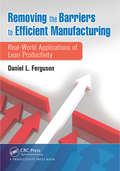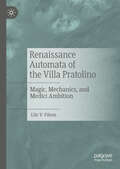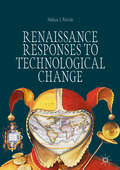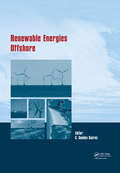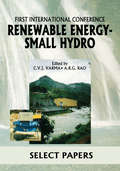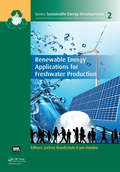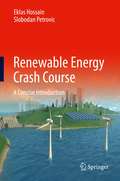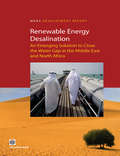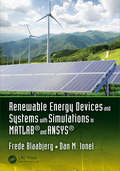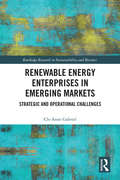- Table View
- List View
Removal and Degradation of Pharmaceutically Active Compounds in Wastewater Treatment (The Handbook of Environmental Chemistry #108)
by Sara Rodriguez-Mozaz Paqui Blánquez Cano Montserrat Sarrà AdroguerThis book reviews water treatment technologies for the removal of pharmaceutically active compounds (PhACs). It provides the reader with an overview of state-of-the-art techniques and recent efforts to develop more sustainable approaches. After nearly two decades of research into the presence and impact of PhACs in the environment, they remain one of the hottest topics in the fields of environmental chemistry, toxicology and engineering. Accordingly, intensive research efforts are currently being devoted to water treatment technologies that can reduce the presence of these emerging contaminants in water bodies. This book examines various types of contaminated water from industry, hospitals and urban wastewater. It provides the reader with a range of potential solutions for water treatment and reuse, and addresses the advancement of analytical tools for evaluating the performance and efficiency of treatment technologies.
Removal of Emerging Contaminants Through Microbial Processes
by Maulin P ShahThe abundance of organic pollutants found in wastewater affect urban surface waters. Traditional wastewater management technologies focus on the removal of suspended solids, nutrients and bacteria, however, new pollutants such as synthetic or naturally occurring chemicals are often not monitored in the environment despite having the potential to enter the environment and cause adverse ecological and human health effects. Collectively referred to as "emerging contaminants," they are mostly derived from domestic activities and occur in trace concentrations ranging from pico to micrograms per liter. Environmental contaminants are resistant to conventional wastewater treatment processes and most of them remain unaffected, causing contamination of receiving water. This in turn leads to the need for advanced wastewater treatment processes capable of removing environmental contaminants to ensure safe fresh water sources. This book provides an up-to-date overview of the current bioremediation strategies, including their limitations, challenges and their potential application to remove environmental pollutants. It also introduces the latest trends and advances in environmental bioremediation, and presents the state-of-the-art in biological and chemical wastewater treatment processes. As such, it will appeal to researchers and policy-makers, as well as undergraduate and graduate environmental sciences students.
Removal of Pollutants from Saline Water: Treatment Technologies
by Shaik FerozRemoval of Pollutants from Saline Water: Treatment Technologies provides a comprehensive understanding of technologies that are currently adopted in the treatment of pollutants present in saline water systems. It provides information on the treatment technologies for saline water systems, including seawater, brackish water, oil-produced water, and other industrial saline wastewaters. FEATURES Presents information exclusively for saline water pollutant removal Introduces current treatment technologies and addresses why and how the techniques differ between fresh and salt water Offers an inclusive overview of physicochemical, biological, membrane, and advanced oxidation treatment technologies Features various perspectives and case studies from relevant global experts Provides a comprehensive one-stop source for the treatment of pollutants in all saline water systems Aimed at students, academicians, researchers, and practicing engineers in the fields of chemical, civil, marine, and environmental engineering who wish to be acquainted with the most recent developments in the treatment of pollutants present in saline water systems. Prof. Dr. Shaik Feroz works at Prince Mohammad Bin Fahd University, Kingdom of Saudi Arabia. He has 30 years of experience in teaching, research, and industry. He has more than 190 publications to his credit in journals and conferences of international repute. He was awarded "Best Researcher" by Caledonian College of Engineering for the year 2014. Prof. Dr. Detlef W. Bahnemann is Head of the Research Unit, Photocatalysis and Nanotechnology at Leibniz University Hannover (Germany), Director of the Research Institute "Nanocomposite Materials for Photonic Applications" at Saint Petersburg State University (Russian Federation), and Distinguished Professor at Shaanxi University of Science and Technology in Xi’an (People's Republic of China). His research topics include photocatalysis, photoelectrochemistry, solar chemistry, and photochemistry focused on synthesis and physical-chemical properties of semiconductor and metal nanoparticles. His 500-plus publications have been cited more than 65,000 times (h-index: 100).
Removal of Refractory Pollutants from Wastewater Treatment Plants
by Maulin P. ShahThis book discusses new and innovative trends and techniques in the removal of toxic and or refractory pollutants through various environmental biotechnological processes from wastewater, both at the laboratory and industrial scale. It focuses primarily on environmentally-friendly technologies which respect the principles of sustainable development, including the advanced trends in remediation through an approach of environmental biotechnological processes from either industrial or sewage wastewater. Features: Examines the fate and occurrence of refractory pollutants in wastewater treatment plants (WWTPs) and the potential approaches for their removal. Highlights advanced remediation procedures involving various microbiological and biochemical processes. Assesses and compares the potential application of numerous existing treatment techniques and introduces new, emerging technologies. Removal of Refractory Pollutants from Wastewater Treatment Plants is suitable for practicing engineers, researchers, water utility managers, and students who seek an excellent introduction and basic knowledge in the principles of environmental bioremediation technologies.
Removing Barriers to Environmental Comfort in the Global South (Green Energy and Technology)
by Alexis Pérez-Fargallo Laura Marín-Restrepo María Beatriz Piderit-Moreno Maureen Trebilcock-Kelly Paulina Wegertseder-MartínezThis book describes how comfort, energy and climate change in developing countries and vulnerable sectors of the population relate to buildings.The building sector is currently facing significant challenges connected to energy consumption, energy poverty and climate change effects. When studied in developing countries and vulnerable sectors of the population, these factors, which are commonplace in the tropics and the southern hemisphere, are interlinked and share a critical component: environmental comfort. Although progress has been made in environmental comfort through research and the development of standards and policies at the international level, in the Global South, where the countries with the highest levels of income inequality are concentrated, environmental comfort has its own characteristics and challenges that prevent a clear understanding from the established vision of the Global North.This book presents research, theories and techniques related to Thermal comfort, Indoor air quality, Visual comfort, and Acoustic comfort and its relationship with energy use and energy efficiency, seeking to address different barriers to environmental comfort. It shows how to improve the way buildings are designed and operated to promote healthier environmental conditions and more sustainable construction, by presenting studies and reflections carried out in the target geographical area: the Global South. In this way, this book contributes to developing the concept of environmental comfort, visualising how progress has been made in understanding it from a tropical and southern perspective, and posing common challenges.The book is intended for engineers, architects, and researchers of the built environment who are interested in environmental comfort and its influence on energy consumption, energy poverty, and other related factors in the Global South context. It is also a useful resource for decision-makers and public policy developers concerned with the indoor comfort of buildings. Moreover, the book aims to provide guidance for those in developing countries by gathering existing knowledge in the field for the tropics and southern hemisphere climatic and sociocultural contexts, allowing us to move forward in this subject with actions and proposed solutions that fit our particular needs.
Removing the Barriers to Efficient Manufacturing: Real-World Applications of Lean Productivity
by Daniel L. FergusonW. Edwards Deming‘s central premise was that improvements in product quality would increase productivity, improve competitive position, and help ensure long-term survival. Point 12 of his landmark 14 Points for Management says that management‘s job is to remove the barriers that keep people from taking pride in their work. That‘s exactly what this book is about.Shedding new light on Deming‘s 14 Points, Removing the Barriers to Efficient Manufacturing: Real-World Applications of Lean Productivity outlines time-tested organizational structures and methods to help you reduce variability and deliver high-quality products consistently. It describes the financial losses that can occur as a result of variability and details the specific activities management must engage in to avoid these losses and ensure long-term success.Instead of taking you on a random walk, the book supplies each manufacturing group in your organization with straightforward directions for creating a smooth-running facility with reduced variability. It includes work assignments in each chapter that, if completed in the order presented, will guide you through the creation of the Model Vision for your manufacturing facility. It also:Covers key topics on working with people, including training and retrainingSupplies pointers for working with unions Considers Single Minute Exchange of Die (SMED)Describes how to put it all together with action plansThe book includes a write up on Deming‘s famous Red Bead Experiment as well as an introduction to statistical process control techniques in the appendices. Filled with real-world examples and a case study to illustrate essential concepts, the book arms you with the insight and common-sense approaches required to build on Deming‘s fundamental principles and consistently deliver high-quality pr
Remya Jose's Great Idea (Fountas & Pinnell LLI Red #Level L)
by Sunita ApteMEET REMYA JOSE, TEEN MENTOR For Remya, a busy 14-year-old, there just weren't enough hours in the day. Lots of teens face the same problem. But how many solve it with a new invention?
Renaissance Automata of the Villa Pratolino: Magic, Mechanics, and Medici Ambition
by Lily V. FilsonThis book explores the automata of the Medici Villa Pratolino, focusing on the intersection of art, engineering, and philosophy in the late sixteenth century. The author examines how these &‘living sculptures&’ went beyond traditional Renaissance static forms, blending mechanical innovation with artistic expression. Through a detailed analysis of the villa&’s automata and Francesco de' Vieri's 1587 description of the site, the book highlights the philosophical and magical ideas that shaped these creations, reflecting the Medici family&’s ambition to fuse science, art, and power. Providing a critical bridge between medieval and Renaissance anthropomorphic engineering, and the later mechanistic devices of the Reformation and Enlightenment, this book will appeal to scholars of Renaissance art, the history of technology, and the philosophy of science, offering new insights into the role of automata in Early Modern European culture.
Renaissance Responses to Technological Change
by Sheila J. NayarThis book foregrounds the pressures that three transformative technologies in the long sixteenth century—the printing press, gunpowder, and the magnetic compass—placed on long-held literary practices, as well as on cultural and social structures. Sheila J. Nayar disinters the clash between humanist drives and print culture; places the rise of gunpowder warfare beside the equivalent rise in chivalric romance; and illustrates fraught attempts by humanists to hold on to classicist traditions in the face of seismic changes in navigation. Lively and engaging, this study illuminates not only how literature responded to radical technological changes, but also how literature was sometimes forced, through unanticipated destabilizations, to reimagine itself. By tracing the early modern human’s inter-animation with print, powder, and compass, Nayar exposes how these technologies assisted in producing new ways of seeing, knowing, and being in the world.
Renaturierung von Waldböden: Prinzip der biologischen Intervention (essentials)
by Stefan Kunze Kai BlanckDas Buch zeigt Wege, Wälder gegen Trockenheit und Klimawandel zu stabilisieren. Der Waldboden muss dazu viel stärker beachtet und durch biologische Maßnahmen gestärkt werden. Gerade auf sauren, nährstoffarmen Standorten, wo Fichten und Kiefern in Monokulturen wachsen, führt das punktuelle Einbringen von Biokompost zum Rückgang der Versauerung und damit zur Revitalisierung von Boden und Pflanzen. Die über Jahre erprobte „Biologische Intervention“ gibt den Bäumen neue Kraft, die sie zukünftig brauchen. Die Humusanreicherung bringt mehr Leben in den Boden. Nur ein gesunder Boden kann gesunde Bäume tragen.
Renewable Biofuels
by Vandana Rana Diwakar RanaThis book offers a complete introduction for novices to understand key concepts of biocatalysis and how to produce in-house enzymes that can be used for low-cost biofuels production. The authors discuss the challenges involved in the commercialization of the biofuel industry, given the expense of commercial enzymes used for lignocellulose conversion. They describe the limitations in the process, such as complexity of lignocellulose structure, different microbial communities' actions and interactions for degrading the recalcitrant structure of lignocellulosic materials, hydrolysis mechanism and potential for bio refinery. Readers will gain understanding of the key concepts of microbial catalysis of lignocellulosic biomass, process complexities and selection of microbes for catalysis or genetic engineering to improve the production of bioethanol or biofuel
Renewable Electricity and the Grid: The Challenge of Variability
by Godfrey Boyle?Integrating intermittent renewable energy sources like wind into electricity systems must be one of the most misunderstood issues in energy policy. This edited volume brings together a unique series of authoritative articles on the topic. There should be no excuse for misunderstanding from now on.? JIM SKEA, RESEARCH DIRECTOR, UK ENERGY RESEARCH CENTRE ?The future design and operation of electric power systems with large injections of renewable energy generation is the subject of much debate, and some misunderstanding. This timely book, from a number of authors with expertise in the area, makes an important contribution to our understanding of this topic.? NICK JENKINS, PROFESSOR OF ENERGY SYSTEMS, UNIVERSITY OF MANCHESTER ?We know the future will be different from the past. This book predicts how large proportions of renewable energy can be incorporated into electricity grids, without harm from the natural variability of these supplies. The chapter authors have different approaches and vision, yet the overall message is positive. Not only can we move to dominant use of renewable electricity, but we can do so utilizing many technological and efficiency improvements, with consumers benefiting from clean electricity at acceptable cost.? PROFESSOR JOHN TWIDELL, GENERAL EDITOR, WIND ENGINEERING 'Anyone interested in renewable electricity will find this book an important reference. It answers many of teh questions so often raised in public debates' Sherkin Comment Can renewable energy provide reliable power? Will it need extensive backup? The energy available from wind, waves, tides and the sun varies in ways that may not match variations in energy demand. Assimilating these fluctuations can affect the operation and economics of electricity networks, markets and the output of other forms of generation. Is this a significant problem, or can these new sources be integrated into the grid system without the need for extensive backup or energy storage capacity? This book examines the significance of the issue of variability of renewable electricity supplies, and presents technical and operational solutions to the problem of reconciling the differing patterns of supply and demand. Its chapters are authored by leading experts in the field, who aim to explain and quantify the impacts of variability in renewable energy, and in doing so, dispel many of the myths and misunderstandings surrounding the topic.
Renewable Energies
by Fausto Pedro García Márquez Alexander Karyotakis Mayorkinos PapaeliasThis book provides a comprehensive overview of current renewable energy technologies and their basic principles. It also addresses the financial aspects of renewable energy projects and analyzes their profitability, covering the most relevant topics for engineers, economists, managers and scientists who are actively involved in renewable energy research and management. The authors are professionals and researchers who are active in the industry, and supplement the main content with revealing case studies and best-practice examples.
Renewable Energies Offshore
by C. Guedes SoaresRenewable Energies Offshore includes the papers presented in the 1st International Conference on Renewable Energies Offshore (RENEW2014), held in Lisbon, 24-26 November 2014. The conference is a consequence of the importance of the offshore renewable energies worldwide and an opportunity to contribute to the exchange of information on the dev
Renewable Energies and European Landscapes
by Marina Frolova María-José Prados Alain NadaïThis book provides timely, multidisciplinary cross-national comparison of the institutional and social processes through which renewable energy landscapes have emerged in Southern Europe. On the basis of case studies in these countries, it analyzes the way in which and the extent to which the development of renewable energies has affected landscape forms and whether or not it has contributed to a reformulation of landscape practices and values in these countries. Landscape is conceived broadly, as a material, social, political and historical process embedded into the local realm, going beyond aesthetic. The case studies analyze renewable energy landscapes in Southern Europe on different political and geographical scales and compare different types of renewable energy such as wind, hydro, solar and biomass power. The contributors are leading experts from Spain, France, Italy and Portugal. The book is intended for researchers, graduate students and professionals interested in geography, landscape and planning.
Renewable Energy - Small Hydro
by C.V.J. Varma and A.R.G. RaoThis is a collection of conference papers on small hydro renewable energy, covering such topics as: resource assessment and planning; design and construction; and plant and equipment.
Renewable Energy Applications for Freshwater Production (Sustainable Energy Developments)
by Jan Hoinkis Jochen BundschuhWorldwide, many regions have a great potential to cover part of their pressing water needs by renewable energy powered water treatment processes using either thermal or membrane based technologies. Not only arid and semiarid regions are increasingly suffering from water shortage but also many other regions face a limitation of freshwater resources either by increasing contamination of surface water bodies or groundwater resources unsuitable for drinking and irrigation purposes either due to their high grade of mineralization or their contents of toxic components. In many areas without centralized water supply, treatment techniques using locally available renewable energy resources such as wind, solar and geothermal can provide an economical, social and environmentally sustainable option for clean water production from seawater and from highly mineralized or otherwise unsuitable ground- and surface water. This book provides an overview on possible cost-efficient techniques and application opportunities for different scales and shows why the implementation of these technologies faces numerous technological, economic and policy barriers and provides suggestions how they can be overcome. It serves as a synoptic compendium of the fundamentals of freshwater production using renewable energies, applicable to all types of water, ranging from brackish to marine water and also including industrial and communal residual water. The book is aimed at professionals, academics and decision makers worldwide, working in the areas of water resources, water supply,land planning, energy planning, greenhouse gases emission mitigation and rural development.
Renewable Energy Based Solutions (Lecture Notes in Energy #87)
by Nader Javani Tanay Sıdkı UyarThis book discusses the main renewable energy resources, along with the current challenges that make it difficult achieve 100% decarbonized energy sources. It presents the perspectives of international expert authors in the field, giving readers a multi-dimensional view of the subject.The book explores numerous approaches for a smooth transition from fossil fuels to renewable energies, including those based on engineering methods, as well as policies, strategies, and social perceptions. It presents several case studies and examples from industry, showcasing the potential role of renewable sources and their challenges. The inclusion of both established methods and cutting-edge developments will make this book of interest to academics, industry professionals, policy makers, and graduate students alike.
Renewable Energy Crash Course: A Concise Introduction
by Slobodan Petrovic Eklas HossainThis book is a concise reader-friendly introductory guide to understanding renewable energy technologies. By using simplified classroom-tested methods developed while teaching the subject to engineering students, the authors explain in simple language an otherwise complex subject in terms that enable readers to gain a rapid fundamental understanding of renewable energy, including basic principles, the different types, energy storage, grid integration, and economies. This powerful tutorial is a great resource for students, engineers, technicians, analysts, investors, and other busy professionals who need to quickly acquire a solid understanding of the science of renewable energy technology.
Renewable Energy Desalination
by Bekele Debele NegewoThe Middle East and North Africa (MENA) Region is one of the most water stressed regions in the world. Water scarcity has already become a challenge to development in many of the countries. Due to increasing population and Projected climate change impacts, MENA's annual water demand gap is projected to grow five-fold by 2050, from today's 42 Km3 to 200 km3 by 2050. Despite its extreme scarcity, water is managed poorly. Inefficiencies are common in the agriculture, municipal and industrial systems; and many utilities are financially unsustainable. As a result, countries overexploit their fossil aquifers-and use desalination by fossil fuel-to meet the water demand gap. Desalination already plays a critical role in MENA's water supply portfolio. However, desalination is costly, energy intensive and has environmental impacts. On current trends, the projection is that, by 2050, Saudi Arabia and many other countries in the Region will consume for desalination most of the oil that they produce. Overexploitation of fossil aquifers is not sustainable. Neither is the use of fossil fuel for desalination to meet the growing water gap sustainable. This book outlines the challenges in terms of water (and also in terms of energy) that countries in the Region face and analyzes the scope of available options to address the growing water gap. The book estimates MENA's water gap today and into the future-until 2050; and presents a methodology to prioritize options to bridge the water gap, using the 'marginal cost of water' approach. The book also assesses the viability of renewable energy desalination as an important option to close the Region's water gap. The book compares the economic cost of desalination using fossil fuel and renewable energy sources, in particular the Concentrated Solar Power (CSP). The book also provides recommendations as to how CSP based desalination could ensure sustainable water supply for the Region.
Renewable Energy Development: Technology, Material and Sustainability (Clean Energy Production Technologies)
by Santosh Kumar Vivek Kumar SinghThis edited volume is a comprehensive guide to understanding and harnessing the power of renewable energy for a sustainable future. In a world dealing with the urgent need to combat climate change and reduce our dependence on fossil fuels, this book provides a new perspective on renewable energy. It is filled with cutting-edge research and practical insights, exploring the technologies, advanced materials, and sustainability practices driving the renewable energy revolution. Renewable energy resources are developing the latest advancements in solar, wind, hydro, geothermal, biomass, tidal, and wave energy technologies. This book is unique and opens a new window on classic renewable energy sources as well as new developments in technology, advanced material innovation, and sustainability aspects leading with various factors such as energy storage, transmission, institutional and economic factors, renewable energy application in smart cities, building and other solar thermal applications, environmental aspects, electrical energy generation, and climate change mitigation potential to achieve net-zero targets. This book is of interest to teachers, researchers, climate change scientists, capacity builders, and policymakers. Additionally, the book serves as an additional reading material for undergraduate and graduate students of sustainable energy, engineering, material science, and environmental sciences. National and international energy, sustainable and material scientists, managers, and policymakers will also find this to be a useful read.
Renewable Energy Devices and Systems with Simulations in MATLAB® and ANSYS®
by Frede Blaabjerg Dan M. IonelDue to the increasing world population, energy consumption is steadily climbing, and there is a demand to provide solutions for sustainable and renewable energy production, such as wind turbines and photovoltaics. Power electronics are being used to interface renewable sources in order to maximize the energy yield, as well as smoothly integrate them within the grid. In many cases, power electronics are able to ensure a large amount of energy saving in pumps, compressors, and ventilation systems. This book explains the operations behind different renewable generation technologies in order to better prepare the reader for practical applications. Multiple chapters are included on the state-of-the-art and possible technology developments within the next 15 years. The book provides a comprehensive overview of the current renewable energy technology in terms of system configuration, power circuit usage, and control. It contains two design examples for small wind turbine system and PV power system, respectively, which are useful for real-life installation, as well as many computer simulation models.
Renewable Energy Engineering
by Janaka Ekanayake Nick JenkinsThis book provides a quantitative yet accessible overview of renewable energy engineering practice and the technologies that will transform our energy supply system over the coming years. Covering wind, hydro, solar thermal, photovoltaic, ocean and bioenergy, the text is suitable for engineering undergraduates as well as graduate students from other numerate degrees. The technologies involved, background theory and how projects are developed, constructed, and operated are described. Worked examples of the simple techniques used to calculate the output of renewable energy schemes engage students by showing how theory relates to real applications. Tutorial chapters provide background material, supporting students from a range of disciplines and ensuring they receive the broad understanding essential for a successful career in the field. Over 150 end-of-chapter problems are included with answers to the problems available in the book and full solutions at www. cambridge. org/jenkins, password-protected for instructors.
Renewable Energy Enterprises in Emerging Markets: Strategic and Operational Challenges (Routledge Research in Sustainability and Business)
by Cle-Anne GabrielThis book highlights the challenges faced by renewable energy enterprises (REEs) in emerging markets, by reflecting on the enterprises&’ own stories and experiences. Research into REEs has focused largely on successful businesses and business models, and developed markets. With significant opportunities for renewable energy enterprise in emerging markets, this book presents a unique business-level perspective. It highlights the key barriers and outlines the strategic and operational solutions for success articulated by the entrepreneurs themselves. The research draws on interviews with entrepreneurs in twenty-eight emerging markets, including Barbados, Cambodia, Chile, Ghana, Indonesia, India, Kenya, South Africa and Uganda. The book concludes by summarising the key solutions for success and illustrating how successful REEs put them into practice. This book will be of great interest to students and scholars of renewable energy, sustainable business and the sustainability agenda in emerging markets.
Renewable Energy Generation and Value Addition from Environmental Microfiber Pollution Through Advanced Greener Solution (Environmental Science and Engineering)
by Alok Prasad Das Ipsita Dipamitra Behera Narayan Prasad DasThe majority of clothes we use regularly are made up of plastic-based materials like polyester, rayon, nylon, and acrylic. When these garments are washed in laundries, they give out tiny plastic fragments termed microfibers which end up in the environment and more precisely in the oceans. Plastic and synthetic polymer wastes which are often irresponsibly discarded into natural habitats undergo bio-fragmentation to give out huge amounts of microplastics and microfibers. Synthetic microfiber pollution has been reported in diverse ecosystems ranging from land and aquatic ecosystem to shorelines and seafloors. Due to the miniature size of the microfibers, it is difficult to detect, investigate, and prevent this type of pollution that is occurring on a larger scale. It is estimated that millions of tons of microfibers are released into the ocean from various sources. They are more toxic because they are more persistent and take a long time to degrade, and it gets accumulated in the environment along with other pollutants. This increases the chances of living organisms in the biosphere ingesting the synthetic microfibers causing harm to the ecosystem and entering into the food chain adversely affecting human beings. It had become a great field of research because of its abundance and the challenges in the identification of synthetic and semisynthetic microfibers from the environmental samples and the time it takes to be degraded. This book focuses on renewable energy generation and value addition from environmental microfiber pollution through advanced greener solution, thus building an economic supportable society as an elementary need of developing countries.





